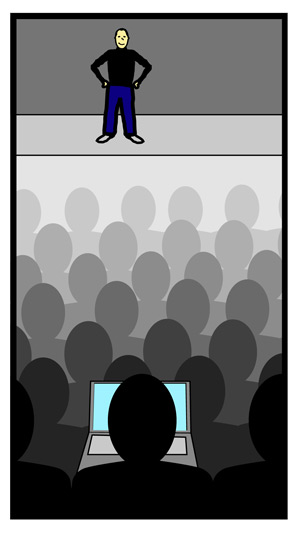 I want to take a look at how two websites covered a single live event, and identify the pros and cons in each reporting style.
I want to take a look at how two websites covered a single live event, and identify the pros and cons in each reporting style.
- The event: Macworld keynote with Steve Jobs, CEO of Apple.
Steve’s presentation is known for compelling product announcements, and as one of the best presentations in consumer electronics that you will see all year. - The websites: Macrumors and Engadget
Macrumors focus on rumors and news about Apple products. Engadget is one of the biggest blogs out there, covering all consumer electronics.
Here is my breakdown of what each did well as I experienced the keynote speak via text and photo updates every few minutes for an hour and a half:
- Easy to read updates
Macrumors set their webpage to update automatically. Every minute or two, the page would add a new update on what was happening on stage. Engadget on the other hand required me to refresh the browser page whenever I thought an update might be posted. Sometimes the page wouldn’t come up, due to the massive amount of people trying to load that page the same time I was. Also – I had to then scroll down the page to find where I last left off.This is where technology really paid off… setting up a special page that functions the way Macrumors’ site did, made it the de facto page for me to go to for instant updates. Winner: Macrumors.
- Photo updates
Both sites provided constant photo updates. Macrumors treated photos as a separate stream on the page – with photos on the right, and text on the left. Engadget included photos within their text updates.While Engadget’s page is extremely readable after the event, the Macrumors design really worked for me as the event unfolded. It looks to me that they posted far more photos than Engadget. Also, it was easy for me to follow updates, as my eyes knew where to check on the page for updates. Very little scrolling. Winner: Macrumors.
- Reporting starts well before the event
This event is so big, that both sites had posts and recaps of rumors during the run up to the event. The moment there were photos or any information, each site would post an update to build enthusiasm.Also, both created a dedicated page for live updates before the event started. Instructions were included as to whether you needed to update the page, or whether the page would take care of that for you. You knew what page to stalk before anything even started. Winner: draw.
- Sharing the flavor of the event
Apple has a huge following and culture built around its brand. People are obsessed. Of the two sites, Engadget did a better job of capturing the flavor of the event. Within their reporting, they shared every nuance and detail possible, even before the event started.When the audience was let in the room, they reported on what songs were playing, and how the crowd reacted during the presentation.
With Engadget, I felt more like I was really experiencing the event. Winner: Engadget.
- Providing context within the live reporting
This one is huge for me, and Engadget was by far the winner here. As their editor Ryan Block reported the news from the stage, he provided little reactions where necessary. To me, these were critical to understanding what the news meant. A few examples:When Steve announced the movie studios that Apple has partnered with on movie rentals:
“We’ve got participation of great studios. Touchstone, MGM, Miramax,… and these six too. Lions Gate, Fox, WB, Walt Disney, Paramount, Universal, Sony…”
Ryan added three words that made all the difference to me:
“Everyone! Huge applause”
Why is this important? Because I had no idea if these 10 studios were considered all of the big studios, or whether this was a letdown. Right away, I knew Apple scored.
When Steve announced that you can stream photos over the new version of Apple TV:
“Get photos from your computer… get them also right over the internet from Flickr and .mac.”
Ryan’s response let me know that Apple was the first to give Flickr support:
“Flickr support, good gawd yall.”
Ryan even shared the audience’s mood, with a sort of rating system that bottomed out at “mild applause,” and topped out with “rumbling applause.”
Overall, this gave a flavor to their reporting, and gave me much deeper insight into the news I was hearing. Winner: Engadget.
Some other notes about this and other live blogging events:
- Macrumors had a sponsor for their coverage, and included a message from them within the live stream a few times. To me, this was completely non-offensive. Good for them.
- The sidebars allow a site to promote related info, which doesn’t just drive page views, but gives a sense of authority on the topics being covered.
- Comments and forums are two ways for the audience to participate on the site itself.
It would be interesting to get a live stream of reader reactions next to the news announcements. - Steve’s speech caused so much activity on Twitter, that the system was down for awhile. This is where people were really experiencing the event as a disaggregated community. Amazing.
Overall – both sites had pros and cons, and lessons to be learned for how to live blog an event. While Macrumors, to me, had the most instantaneous reporting, I walked away with a better feeling towards Engadget’s coverage. Their personality and addition of context turned this from straight news reporting, to an experience I shared with them.
